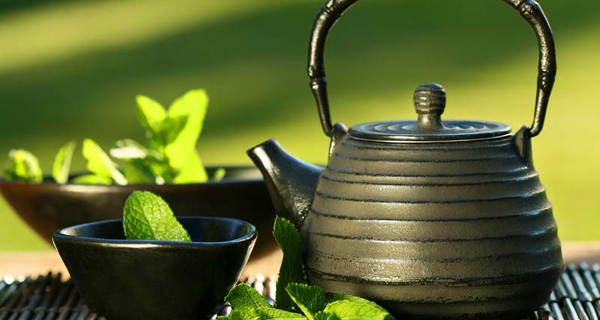
Green Tea (Camellia sinensis)
Green tea is grown predominantly in China, Japan and India, with each country producing different and unique varieties. There are two methods of growing green tea- directly under the sun or with varying degrees of shade. Each method produces varying degrees of the preservation of green tea’s natural antioxidants and polyphenols. Green tea is harvested between three to four times per year, with the premium harvest season being from late April to early May, then June to July, late July to early August and possibly the last harvest later in the year. The different types of green teas and their growth method also dictates varying processing methods, but all generally share the steps of fresh leave harvesting, steaming, drying and rolling several times before the final drying, removal of stems and dust, and finally, shaping, grinding or roasting, depending on the region the tea comes from. Green Tea is extremely popular all over Asia but particularly so in Japan. Exuding a unique and often strong grassy flavor, Green Tea has long been exalted for its health benefits which include lowering high blood pressure, high cholesterol, fighting multiple types of cancer, helping to maintain overall health and aids in weight loss.
- Dragonwell (China)
- Chun Mei (China
- Makaibari Tea Estates (India)
- Craigmore Estate (India)
- Sencha (Japan)
- Gyokuro (Japan)
White Tea (Young leaves of Camellia sinensis)
White tea and green tea both come from the Camellia Sinensis plant but are harvested at very different times with differing processes. White tea is harvested before the tea leaves have even fully opened and are still covered in small, fine white hairs which gave this tea’s obvious name. Studies of the health benefits of different types of teas have shown that White tea possesses multiple times the concentration of antioxidants than green tea so one can only imagine just how powerful these leaves are. White tea is the least processed of all teas, producing a beautiful, light golden color when brewed. With less caffeine than green tea, white tea also exudes a much subtler and mild flavor compared to all other types of teas, often described as “aromatic water.” Premium white tea is harvested in a two day period in early spring. Health benefits of white tea include all those of green tea such as helping to maintain a healthy immune system, fighting off many types of cancers, lowering high blood pressure and high cholesterol, but all to a more powerful degree. White tea has also been shown to help prevent tooth decay and plaque. Typically more expensive than all other teas, white tea is hand-picked from various regions throughout Asia. Popular types of white tea include:
- Silver Needle (China)
- White Peony (China)
- Long Life Eyebrow (China)
- White Pu-erh (China)
- Darjeeling White (India)
- Ceylon White (Sri Lanka)
Black Tea (Camellia sinensis)
Thought Black Tea comes from the same tea bush as both Green and White teas, the major difference is that black tea leaves are allowed to completely oxidize, creating a more robust and stronger flavor. Due to the oxidation process, Black Tea has the least health benefits of the teas, retaining far less of the antioxidant properties attributed to White and Green teas. However, certain research indicates that drinking Black Tea in moderate but consistent proportions may help prevent cavities and heart attacks. Black Tea contains more caffeine than White, Green and Oolong, making this popular beverage an excellent alternative to coffee. Black Tea varieties were originally the most popular types of teas in the West, long before Green, White and Oolong were introduced or widely enjoyed. The popularity of Black Tea in the West may also be attributed to the past British occupation of the major tea producing regions such as India and Ceylon. Types of popular Black Tea include:
- Earl Grey (Ceylon or Sri Lanka)
- English Breakfast (Ceylon or Sri Lanka)
- China Black (China)
- Keemun (China)
- Lapsang Souchong (China)
- Assam (India & Nepal)
- Darjeeling (India)
- Ceylon (Ceylon or Sri Lanka)
Oolong Tea (Black Dragon) (Camellia sinensis)
Oolong Tea is native to the Wuyi Mountain region of China. With an oxidation grade between Green and Black Teas, Oolong is one of the most popular teas served throughout China and in Chinese restaurants in the West. Oolong Tea is harvested by hand typically in a particular batch of one bud and three leaves before exposing under the sun. The second stage of drying occurs indoors where each tea producer decides on an exact level of oxidation, usually around 30% red and 70% green. Different tea producers will then go through their unique stages, most often shaking the Oolong tea leaves in large baskets to cause bruising of the tea leaf edges, encouraging the oxidation process, also releasing the Oolong’s caffeine and natural flavors to rise to the surface. The varying times of oxidation and further drying process cause the difference in taste of one Oolong from another, though all Oolong flavors fall in the spectrum between Green and Black Teas. Health benefits of Oolong Tea are identical to those of Green Tea though to a lesser degree of power. The one health benefit that Oolong Tea possesses in stronger form than all other teas is its ability to facilitate weight loss. Oolong Tea is also typically brewed in small Chinese tea pots and enjoyed with what may be classified in the West as miniature tea cups. Types of Oolong Tea include:
- Iron Goddess or Kuan Yin (China)
- Formosa (Taiwan)
- Darjeeling Oolong (India)
- Luohan or Iron Arhat (China)
- Da Hung Pao (China)


 Welcome to Food, Travel & Life with The Asian Fusion Girl. Learn more about the AF Girl and her various projects
Welcome to Food, Travel & Life with The Asian Fusion Girl. Learn more about the AF Girl and her various projects




